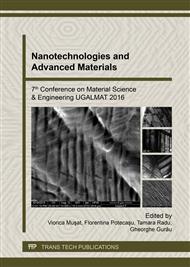p.133
p.139
p.145
p.154
p.160
p.167
p.174
p.180
p.188
Experimental Study on the Stability Level Assessment of Mini-Implants for Orthodontic Anchorages
Abstract:
This paper presents some results of the experimental investigations that were aimed at assessing the primary stability of orthodontic mini-implant anchorage by measuring the tensile force with a special device adapted for traction in the axial direction and at a 45 degree angle, taking as variables bone characteristics (thickness and cortical bone density, thickness and density of the medulla). We used samples (pork ribs) whose characteristics were measured at computer tomography with a specialized software, in which there have been inserted orthodontic mini-implants with spherical head, round thread having different characteristics of shape and dimensions of the thread (length diameter, pitch). Experiments have provided information on the relationship between bone characteristics of samples and maximum traction force in the axial direction and at 45degree angle, as well as mini-implant primary stability.
Info:
Periodical:
Pages:
160-166
Citation:
Online since:
February 2017
Price:
Сopyright:
© 2017 Trans Tech Publications Ltd. All Rights Reserved
Share:
Citation:


